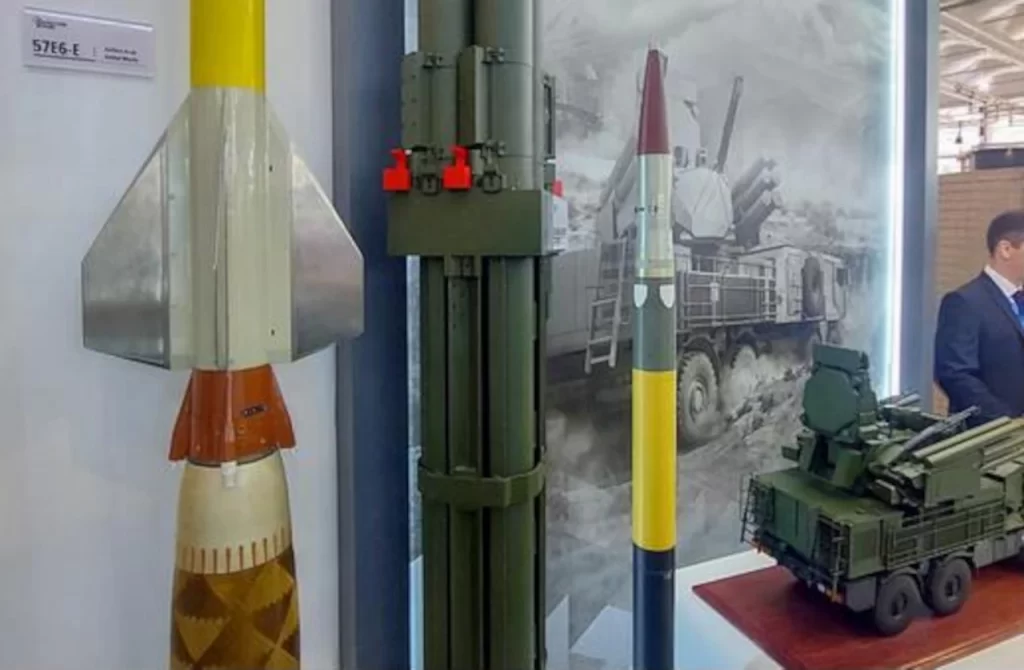The testing of the new modification of the anti-aircraft missile and gun system (AAMS) “Pantsir-SM-SV” is nearing completion, demonstrating its compliance with the Russian Ministry of Defense requirements.
TASS news agency on January 2 reported, quoting the state corporation “Rostec”, that the Pantsir-SM-SV is intended to provide cover for the Russian ground forces. It is characterised by being mounted on a new tracked chassis. This chassis will allow the system to accompany and cover air defence systems as they move through snow and rugged terrain. Furthermore, it has two types of guided anti-aircraft missiles and a larger engagement zone. Introducing the “Pantsir-SM-SV” into service will greatly improve air defence capabilities at low altitudes and in the close-in zone.
In August 2023, Frontier India reported that adapting the “Pantsir-SM-SV” anti-aircraft missile-gun system for the Ground Forces necessitates using two unique guided anti-aircraft missile types and an enhanced engagement range. The combat vehicle’s anti-aircraft gunner crew might use already available MANPADS systems like “Igla,” “Igla-S,” and “Verba,” as well as the anticipated next-generation MANPADS called “Metka.”
Furthermore, the modern ‘Ptitselov’ surface-to-air missile (SAM) system consists of two unique missile types that use different guiding techniques: infrared homing and laser guidance.
Pantsir-SM
The “Pantsir-SM” sets itself apart from other air defence missile systems in its family by incorporating a new radar system with integrated Active Electronically Scanned Array (AESA) technology. As a result, the system’s ability to detect and track targets has substantially improved.
The system begins to engage targets practically at ground level. Automatic cannons and guided missiles with radio command guidance and infrared and radar tracking offer air defence. The Pantsir’s multi-channel target acquisition and tracking system is one of its distinguishing features, along with missile and artillery armament. This means that the same system controls both missile and gun firing.
The gun armament comprises four 30mm automatic rapid-fire guns (2A38M). The overall firing rate is 5000 rounds per minute, with a cartridge capacity of 1400 rounds.

The new radar allows the “Pantsir” to identify potentially harmful threats from up to 75 km. In addition, the designers increased the range of engaging air targets to 30-40 km, up from 15-20 km in the original model.
The “Pantsir’s” firepower has also increased. The initial air defence missile system had 12 ready-to-fire missiles, but the “SM” type can carry up to 18 missiles. Furthermore, the variety of munitions utilised has been enhanced. The “SM” model’s most intriguing innovation is the so-called “nails,” which are small-calibre missiles meant to destroy unmanned aerial vehicles (UAVs). The newly developed missiles are distinguished by their small size and comparatively low production costs. Each anti-UAV installation comprises four missiles. Thus, if the “Pantsir” is only armed with anti-UAV missiles, the total number of missiles on combat duty will be 72.
The “Pantsir” complex was first presented in the 1990s and has progressed significantly since then. The new AASM was developed in 1994. The armament system was officially unveiled during the MAKS-1995 exhibition. The trials of the army model “Pantsir-S1” began in 2006. Two years later, the Russian army inducted the air defence system. However, progress continues, and the “Pantsir” has received two important upgrades since then. The first time was in 2015 when the “S2” model debuted. The system underwent another update and acquired the “SM” index a year later. The latest “Pantsir” variants have recently begun to see widespread deployment in combat.
Last year, the official spokesperson for High-Precision Complexes JSC, which is in charge of developing missile systems for the domestic air defence system, reported the successful development and integration of hypersonic anti-aircraft interceptor missiles into the Pantsir system. When manoeuvring in the air, these missiles have incredible speed at their disposal.
According to the manufacturers, the upgraded version of Pantsir demonstrates a rate of effectiveness of one hundred per cent when it is used to counter the HIMARS MLRS. The arsenal of HIMARS includes a wide variety of missiles, each of which may travel at a different speed and a varied range. In addition, the system’s capability of successfully intercepting missiles like Storm Shadow and SCALP EG has been significantly enhanced.
However, it is essential to note that the effectiveness of the “Pantsir-SM” in fighting HIMARS missiles and unmanned aerial vehicles (UAVs) is contingent upon several conditions. The “Pantsir-SM” positioning is important as it provides the greatest possible airspace coverage. Because of this, it will be able to identify HIMARS missiles and unmanned aerial vehicles on time. The adversary’s unmanned aerial vehicles (UAVs) and HIMARS missiles may be equipped with electronic countermeasures (ECM), making detecting and intercepting these targets more difficult. The ECM capabilities of the “Pantsir-SM” are designed to counter the enemy’s ECM capabilities. The ability of the “Pantsir-SM” to detect, identify, and intercept targets promptly depends on the professionalism of its crew. The system takes five minutes to deploy and is managed by just three personnel.
